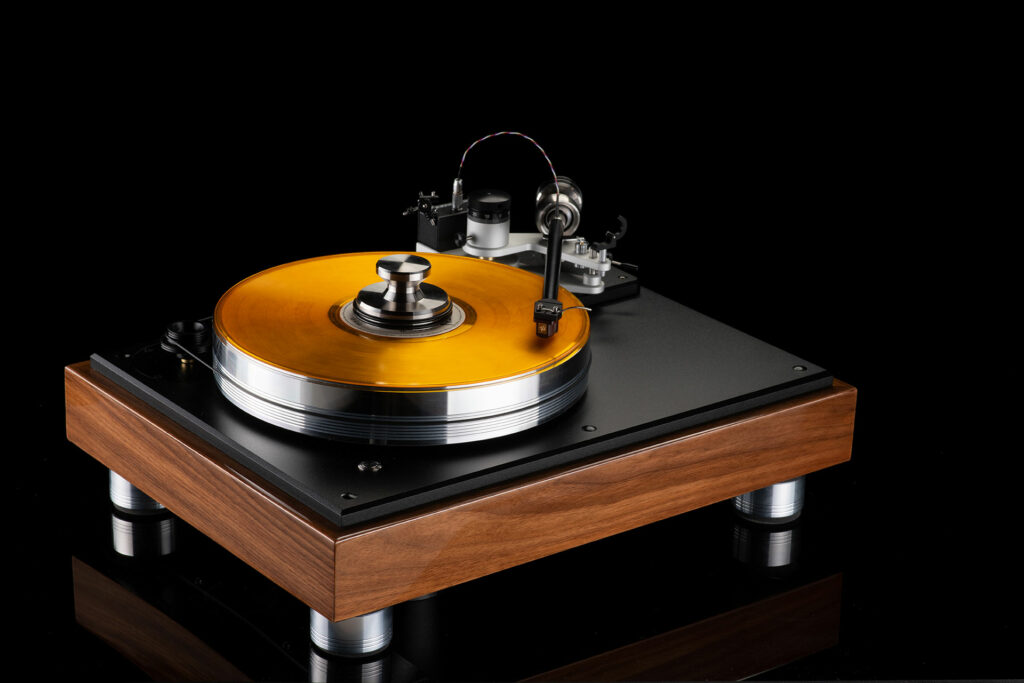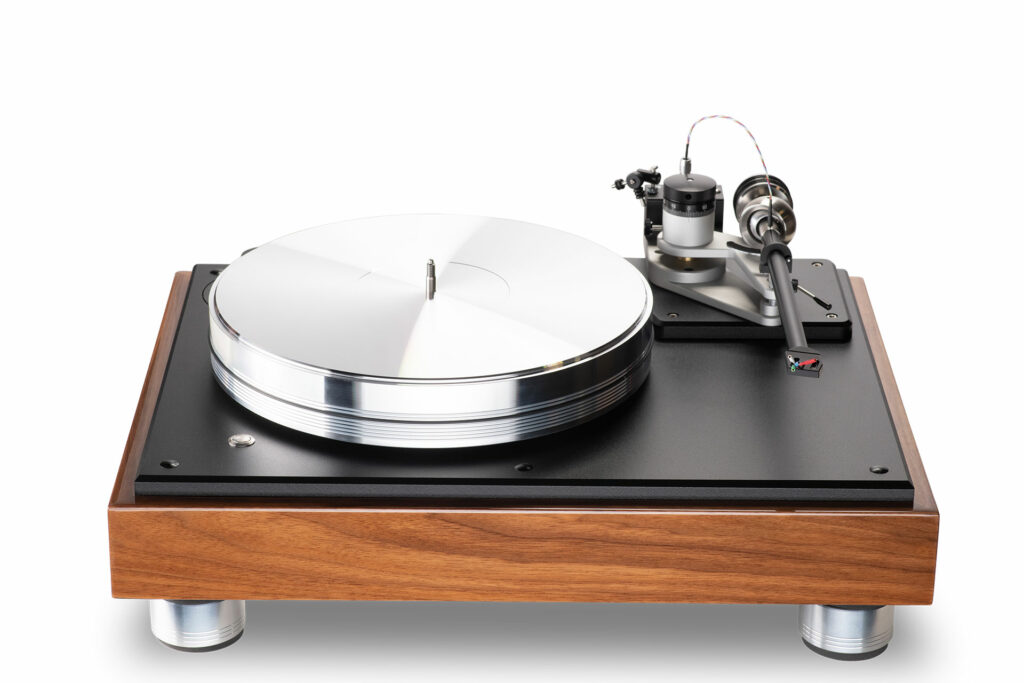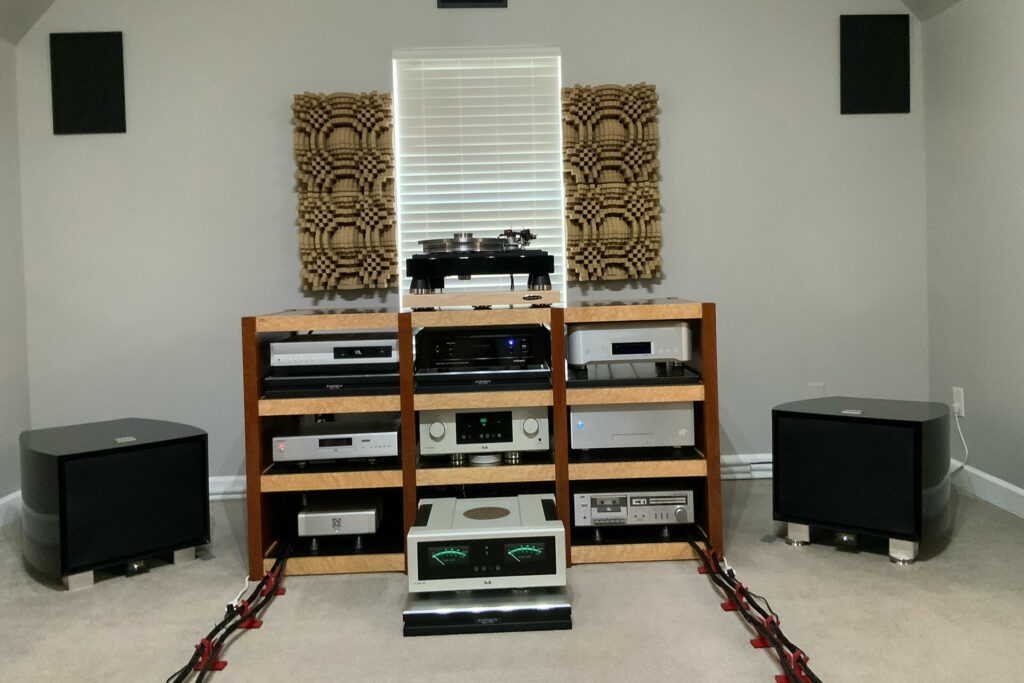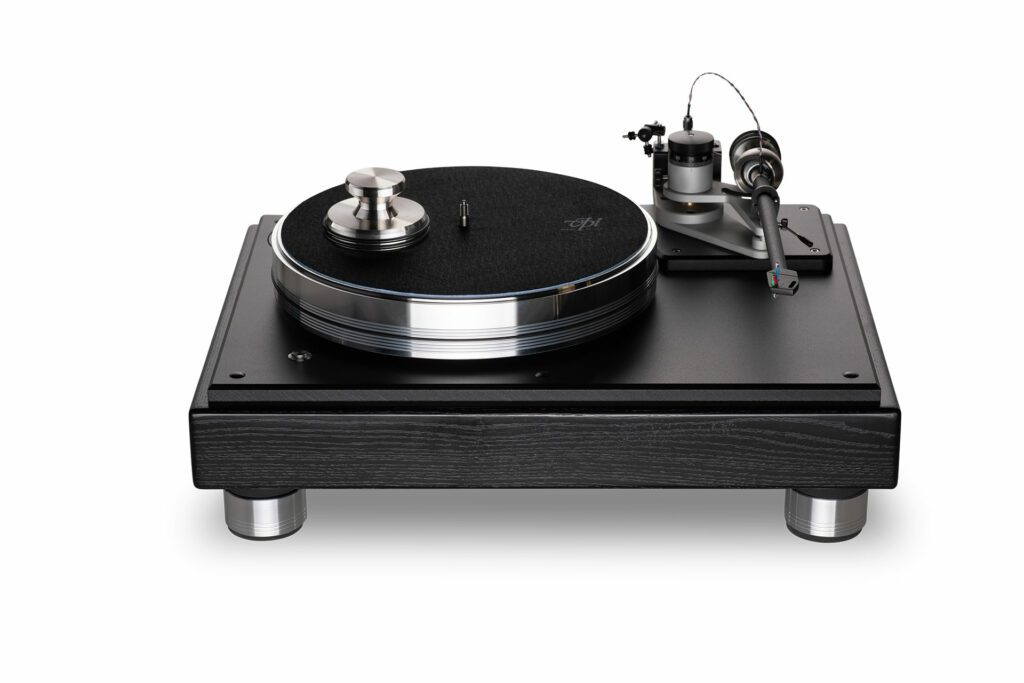When Harry Weisfeld founded VPI Industries in 1978, he probably could have never imagined his modest company, initially known for making record weights and isolation bases, would become the market leader it is today. His first commercially successful turntable was the VPI HW-19, introduced in 1980. Several updated versions followed and more audiophiles began taking notice of this New Jersey-based company. The VPI Classic series of audiophile turntables traces its lineage to 2008 with the Classic 1. The subject of this review, VPI’s Classic Signature, was introduced in 2014. Still currently in production, the entire Classic turntable line of products are among the favorites of VPI customers in what today is an almost global customer base.

What Makes the VPI Classic Signature Turntable Special?
- The Classic Signature is a turntable that looks like a turntable. Simple to operate, it does exactly what a turntable should do: it plays a record. It doesn’t blast off into space like some of today’s turntables look capable of.
- The Classic Signature is fabulously well made in the United States. With a platter machined from billet aluminum and a chassis consisting of a gloss walnut veneer, MDF, aluminum, there is an overall solid feel and heft to the unit. Needless to say, it’s quite heavy. Platter weight alone is close to 20 pounds. Total weight is about 65 pounds.
- The robust weight of the VPI Classis Signature Turntable is an excellent guard against internal resonances and interference from external sources, such as placement somewhat close to subs or woofers on primary speakers.
- The main drive motor is a 300 RPM, 24 pole, AC synchronous version with low noise and high torque. VPI claims platter accuracy to ±0.005 inches. That’s very, very good.
- The platter bearing features Thompson Engineering precision shafting with a Rockwell 60 hardened and polished ball running on a PEEK thrust disc. Side thrust is maintained by composite bronze bushings lubricated with graphite. This platter setup ensures a smooth, quiet, and nearly effortless operation.
- A center weight is included to help preserve record flatness. An optional outer periphery ring clamp is also available at an additional charge of $1,300.
- The Classic Signature has excellent speed stability. In the many times I have checked the platter speed, the result has almost never varied, which is quite impressive for any turntable.
- The tonearm is available as either a Unipivot or a Gimbaled version. While the Gimbaled design is now shipping as standard, the Unipivot design is still available. All Gimbaled designs are 3D printed. Only the Unipivot mount is available in aluminum when purchased new.
- A 3D, epoxy printed, 10-inch tonearm is standard on the VPI Classic Signature. All tonearms come standard with VPI Premium Discovery Wiring or the optional upgraded Nordost wiring utilizing the company’s patented FEP Micro/Mono-Filament wire design. A 12-inch version is also available as an optional upgrade.
- The Gimbaled design has a micro threaded shaft to which the counter weight is attached.Tracking force changes are made by a micrometer-style adjustment of a knurled round nut. I especially like this type of counterweight. It allows very precise fine-tuning of the tracking force and is far easier than earlier designs utilizing a counterweight that was manually positioned then secured by tightening a thumbscrew.
- Both tonearm versions have an on-the-fly Vertical Tracking Adjustment. This allows an easy and mostly simple correction of the overall tonearm height so LPs of different thicknesses, such as a standard LP or a 180 gram LP, may be played while maintaining the desired stylus rake angle.
- The base is available in the standard piano Black finish, Black Ash, or a Walnut version.
- An RCA tonearm cable connection box is conveniently mounted on the rear of the tonearm tower. This allows user flexibility in choosing their own preferred cable. The included power cord connects underneath the unit.

Why Should You Care About the VPI Classic Signature Turntable?
As the popularity of vinyl continues to grow, so too does the proliferation of varied and some might say futuristic designs. While some may applaud a lean to a 22nd-century design ethos, VPI decided a simple, classic appearance would also be well received. To many, it just looks like a turntable should look. Additionally, as turntable prices continue to rise, even to prices in the half-million-dollar range, the VPI Classic Signature is a very well-made product in the $6,000 price class. Combining sold engineering, outstanding performance, affordability, and a very enjoyable sonic picture makes this turntable one that may be enjoyed for many years – even as other parts of the audio system continue to evolve.

Some Things You Might Not Like About the VPI Classic Signature Turntable
- There is no provision for speed adjustment on the Classic Signature. Many turntables these days have this capability, making accurate platter speeds even more reliable.
- The Unipivot design, which many VPI turntables have, particularly older models, may make mounting a cartridge quite difficult, depending on the setup skill of the user. Tonearm setup ranks as one of the more difficult things to do in audio and the Unipivot design certainly presents specific challenges. It is not uncommon to spend several hours of frustration trying to accurately dial in one aspect of the setup process while not altering others already completed. I have spent quite a few hours with a Fozgometer dialing in azimuth settings while trying to not alter anything else I had already completed on past Unipivot tonearms. My other turntable, a Luxman PD-151 Mark II, has a Gimbaled design that I find much easier to set up. VPI, as previously mentioned, offers both designs and is now shipping their Gimbaled version as standard. Anyone buying an older version on the used market should recognize the difference.
- While the 3D Epoxy Printed tonearms are produced with a threaded counter weight, in both the Gimbaled and Unipivot variants, the aluminum tonearms still utilize a counterweight manually moved forward or back on the tonearm then secured with a thumbscrew. This makes really dialing in precise counterweight settings somewhat difficult.
- The 3D printed tonearm is subject to damage if the counterweight setscrew is tightened too much. Of course, this is very easily avoided, as the setscrew does not take a lot of tightening to keep the counter weight from moving. One just needs to be careful and realize tonearm damage is possible.
- When changing from the 33-1/3 speed to 45 (there is no 78 option), the belt must be manually moved to a different position on the pulley. Having a button to change motor speed would almost certainly be far preferable to most users.
- There is no dustcover shipped with the VPI Classic Signature or as an optional factory add-on. There are, however, aftermarket versions available, usually retailing in the $300-and-up price range.
Listening To the VPI Classic Signature Turntable…
Overall, the VPI Classic Signature has a rich, full, smooth, and luxurious sound compared to other turntables in its price category. With the obvious mass and the effort put into dampening resonances, I noticed no ill effects from any sort of feedback despite my two REL G1 Mark II subs sitting on either side of my audio rack. The imaging was excellent, easily equivalent to what I experience with the digital section of my system. On several LPs I’ve owned for 40 years or more, I was surprised to discover that after a good cleaning in my ultrasonic cleaning machine, I actually felt the surface noise was surprisingly muted. This is obviously due to the efficiency of ultrasonic cleaning but also to the fact that modern tonearm, cartridge, and stylus technology has improved in the last half century. Bass response was forceful and had an excellent presence. All in all, the VPI Classic Signature delivered an excellent sonic picture and made listening to LPs very enjoyable.
On the track “Freddie the Freeloader” from Miles Davis’ landmark album Kind of Blue, the track begins with a very simple and actually sort of benign trumpet intro that the VPI Classic Signature recreated with excellent pitch and timing. Things roll along at a wonderful pace – trumpet, bass, high hat, and piano seamlessly blending and providing an equivalent level of dynamics.
At the 4:30 mark, John Coltrane lets go with a very impressive sax solo. Jimmy Cobb excels on drums, and this track and the entire album just work. It is no surprise that Kind of Blue is one of the most highly regarded jazz recordings of all time. Best of all, I completely forgot what I was doing and simply got lost in a very familiar musical place. Of course, I also own this work on Compact Disc, and in this instance, the Classic Signature delivered a smooth, relaxed sound that simply captivated my attention and allowed me to get lost in the music, which is so much fun.
In 1971, Carol King released what would go on to be one of the best-selling albums in the history of recorded music. I have a copy of the original version of Tapestry, but even after an ultrasonic cleaning, it still had too much surface noise. I switched to the Mobile Fidelity Ultradisc One Step Pressing and cued up the track “I Feel The Earth Move.” This nearly dead-silent LP easily showcased the simple yet excellent arrangement and made the listening experience laid back and effortless. King’s lyrics are abundantly clear and easily understandable. Imaging was superb, with the piano placement well beyond the left lateral speaker boundary. The guitar was similarly placed to the right, again well beyond the speaker boundary. King’s voice was precisely locked in the center image and never moved. The bass line was very precise and exhibited no rumble or boominess at all. Overall, the clarity was excellent, partly due to the recording but also the turntable’s exceedingly excellent sonic portrayal. Having a wall of sound is something generally reserved for my digital section. That the VPI Classic Signature provided a similar reproduction speaks to how well this turntable performs.
Does the VPI Classic Signature Turntable Have Any Resale Value?
VPI ranks as one of the more prolific brands available on the used market. Because the product line has models priced from about $1,500 retail all the way into six figures, used turntables will always be available. Anyone wishing to sell their Classic Signature on a used website may find several other, as well as numerous other VPI models for sale as well. Used prices tend start at about half of the retail cost down as low as about 40 percent of retail cost. Final sale price may be even less.
So, while there will likely always be an interested buyer, the seller may find one or more competing turntables from which a perspective buyer may choose. It should be understood actual used pricing may not rise above half of retail price. And given the shipping weight of about 100 pounds, freight will undoubtedly be a factor. Also, turntables rank as one of the products most likely to be damaged in shipment – a consideration undoubtedly affecting selling a turntable used. It is therefore absolutely vital the original packaging is saved so if the product is sold, it may be shipped as it was from the factory.

Who Is the Competition for the VPI Classic Signature Turntable?
Like most questions in high-performance audio, this one has quite a few answers. There are countless models and brands at all different price points from which to choose. When, however, we factor in the concept of a classic appearance, there is perhaps no better example than the Linn Sondek LP12, now boasting 50 years of continuous production. The Majik version retails for $5,130, but is so highly customizable, with such a wide variety of options, prices may rise to $30,000. While many love this turntable, the most notable difference is the difficulty of setup. To be done correctly, an authorized Linn dealer needs to set the turntable up when new using special fixtures and tools. This may take as much as four hours. However, when talking about a classic turntable with a formidable sound, the Linn Sondek LP12 is a stout contender.
Another very worthy competitor is the Clearaudio Performance DC Air at $6,000 (depending on tonearm). This is a really strong challenger, in that the chassis is also made of laminations of wood and metal. Where it differs is Clearaudio uses a DC motor as opposed to VPI using an AC motor. Another notable difference is the Clearaudio Performance DC features three speeds: 33-1/3, 45, and 78. Instead of an aluminum platter, Clearaudio uses an acrylic, or more specifically, a polyoxymethylene version. For the price, both are excellent turntables.
Lastly is the Pro-Ject Xtension 12 Evolution at a base price of $5,499 and the Super Pac option (including a cartridge) costing $6.499. For this design, Pro-Ject uses magnets to virtually decouple the main plinth, thus substantially reducing unwanted vibrations. Perhaps the most intriguing aspect of this turntable is the platter. Made from metal, it is dampened on the underside with Sorbothane and has a permanently affixed PVC platter mat that is first glued to the platter and then baked to make what is claimed to be the “perfect platter mat.” Unlike the VPI Classic Signature, the Pro-Ject Evolution has electronic speed control and even includes a dustcover.
Final Thoughts on the VPI Classic Signature Turntable
If, like me, you tend to look favorably on history, the VPI Classic Signature is a standout product. Harry Weisfeld once told me at an audiophile show that he designed the Classic series because he wanted a traditional looking turntable in the VPI lineup. The Classic Signature certainly accomplishes that goal.
While not flashy, not futuristic looking, not made with all manner of exotic materials mostly impossible to spell or pronounce, the VPI Classic Signature is a well-designed turntable that does a superior job of the core function for which a turntable is intended: it plays a record. That it does so with such a high degree of excellence relative to its price is a bonus. Boasting very stable speed and a solid base, plinth, and platter, the VPI Classic Signature simply delivers with exceptional sonics. More, a lot more in fact, may be spent on a turntable, but for the money, for the looks, for the performance, the VPI Classic Signature is an outstanding product deservedly welcomed in most any audio system. If you like and enjoy listening to a vinyl LP, you will have a fantastic time with this one. I sure did.




This review accords with my experience more or less exactly. I purchased a used 2016 Classic Signature w/ the SDS speed control and a 10″ Fatboy gimbaled tonearm a few years ago for a bit less than 50% retail from someone upgrading to an SME. The sonic character and ease of use as described is spot-on. The SDS is now discontinued but I strongly advise interested buyers to invest in the ADS or equivalent product.
I’ve had two issues that don’t seem to be relevant to the reviewer’s experience but have been to mine that possible users should be aware of. One is a very loud ‘pop’ when turning off the turntable. This is a known issue with their motor that VPI will send you parts to fix, but for a product at this price point it shouldn’t be an issue for the client to have to deal with. The second issue I have is a distinct ‘hum’ when I touch the tonearm finger lift. Every effort to eliminate this hum has been unsuccessful, and have it on good authority from Soundsmith that my Carmen MK2 cartridge is not at fault. The cause could be unshielded tonearm wires or grounding issues with the tonearm itself. I’m using the VPI tonearm cable w/ integrated ground wire and have tested other cables so I’m ruling-out unshielded tonearm cables as the cause. It’s not a major concern, however, as the hum ceases when I stop touching it.
Hello Caleb, thanks for the comment.
While I have heard of some users of this turntable experiencing a pop when turning off the power button, I never had that problem myself. Your comment about “don’t seem to be relevant to the reviewer’s experience” is correct. So far, I have yet to hear about anyone with a hum generated by touching the finger lift. This sounds absolutely like a grounding issue. I’m guessing you’ve tried many different options to eliminate this hum. And you know, the funny thing about a system hum is even thought it might not affect the music in any way whatsoever, just the knowledge it is there at all can drive someone crazy!
My only suggestion is to return the tonearm itself back to VPI to be rewired. You can contact them directly and they will work with you regarding the return and rewire of the tonearm. If there is a grounding issue inside the tonearm itself, a complete rewire should clear things up. Assuming, of course, you are 100% positive it is not being caused by anything external to the turntable.
Needless to say, if the hum in no way compromises LP layback, it does beg the question of how much time and effort should be applied to a problem that really doesn’t cause a problem. Unless, of course, the very notion of a hum of any kind is something you find maddening.
One thing I will say, this turntable with a Fat Boy tonearm should sound really wonderful!
Best,
Paul
I also had a good Pop when turning off the turntable. But as I changed a phono preamp, it mostly is gone now.
Yikes.
I am glad that “popping” sound got resolved with a new phono section!